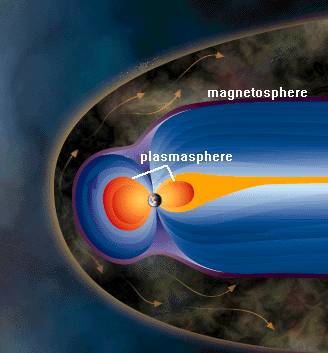
The Earth's Plasmasphere
The Earth's plasmasphere is an inner part of the magneteosphere. It is located just outside the upper ionosphere located in Earth's atmosphere. It is a region of dense, cold plasma that surrounds the Earth. Although plasma is found throughout the magnetosphere, the plasmasphere usually contains the coldest plasma. Here's how it works:
The upper reaches of our planet's atmosphere are exposed to ultraviolet light from the Sun, and they are ionized with electrons that are freed from neutral atmospheric particles. The results are electrically charged negative and positive particles. The negative particles are electrons, and the positive particles are now called ions (formerly atoms and molecules). If the density of these particles is low enough, this electrically charged gas behaves differently than it would if it were neutral. Now this gas is called plasma. The atmospheric gas density becomes low enough to support the conditions for a plasma around earth at about 90 kilometers above Earth's surface.
The electrons in plasma gain more energy, and they are very low in mass . They move along Earth's magnetic field lines and their increased energy is enough to escape Earth's gravity. Because electrons are very light, they don't have to gain too much kinetic energy from the Sun's ultraviolet light before gravity loses its grip on them. Gravity is not all that holds them back, however.
As more and more electrons begin to escape outward, they leave behind a growing net positive electric charge in the ionosphere and create a growing net negative electric charge above the ionosphere; an electric field begins to develop (the Pannekoek-Rosseland E-field). Thus, these different interacting charges result in a positively charged ionosphere and negatively charged region of space above it. Very quickly this resulting electric field opposed upward movement of the electrons out of the ionosphere. The electrons still have this increased energy, however, so the electric field doesn't just go away. Instead the ions react to the electric field and are attracted to it. They begin to move upward out of the ionosphere too. Since all this happens on a small scale, it simply looks like the electrons and ions move out of the ionosphere together. Ultimately the effect is that the lighter ions of hydrogen, helium and oxygen are able to escape from the ionosphere.
For a planet like Earth with a strong planetary magnetic field, these outward moving particles remain trapped near the planet unless other processes further draw them away and into interplanetary space. As is always the case with nature, there is much more story to tell about this "upwardly mobile" plasma and these other processes.
Over only a short time period of hours and days this escaping plasma can, in some places, build up in concentration until an equilibrium is reached where as much plasma flows inward into the ionosphere as flows outward. This "donut shaped" region of cold (about 1 electron volt in energy) plasma encircling the planet is called the plasmasphere.
Because of space weather storms (kind of a generic phrase for those other processes) this cold and dense plasmaspheric plasma can actually end up all over the place. Generally, that region of space where plasma from the ionosphere has the time to build up to become identified as the plasmasphere rotates or nearly rotates with the Earth. That region shrinks in size with increased space weather activity and expands or refills during times of inactivity. As it shrinks with increasing activity, some of the plasmasphere is drawn away from its main body (plasmaspheric erosion) in the sunward direction toward the boundary in space between that region dominated by Earth's magnetic field and the much larger region dominated by the Sun's magnetic field. The region dominated by Earth's magnetic field is called the magnetosphere. The larger Sun-dominated region is called the heliosphere.
Web Links
NOAA's Space Weather Prediction Center - Today's Space Weather Updated Every 5-minutes
National Space Weather Program - The U.S. Government and Space Weather
Responsible Official: Dr. David McKenzie
Last Updated: April 26, 2023
